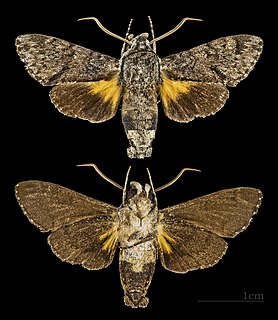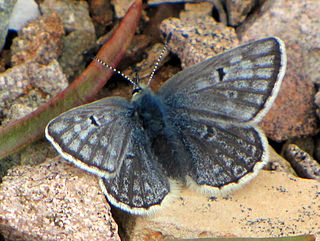
Colias is a genus of butterflies in the family Pieridae. They are often called clouded yellows; the North American name "sulphurs" is elsewhere used for Coliadinae in general. The closest living relative is the genus Zerene, which is sometimes included in Colias.

Cautethia spuria, the spurious sphinx, is a moth of the family Sphingidae. The species was first described by Jean Baptiste Boisduval in 1875. It lives from Mexico to Costa Rica to southern Texas and Oklahoma on the North American continent.

Proserpinus clarkiae, or Clark's sphinx, is a moth of the family Sphingidae. The species was first described by Jean Baptiste Boisduval in 1852. It is known from British Columbia and Washington south through California to Baja California, east to Idaho, Wyoming and Utah. The habitat consists of oak woodland and pine-oak woodland in foothills.

Argina is a genus of tiger moths in the family Erebidae. They are distributed throughout Africa, Mauritius, China, India, Sri Lanka, Myanmar, Andaman Islands, New Guinea and Australia.

Asterocampa clyton, the tawny emperor, is a species of brush-footed butterfly. It is native to North America, especially the eastern half from Canada to northern Mexico. The tawny emperor should not be mistaken for a very similar Asterocampa butterfly, the hackberry emperor, which can be distinguished by the white spots near the front of its wings.

Arctia villica, the cream-spot tiger, is a moth of the family Erebidae. The species was first described by Carl Linnaeus in his 1758 10th edition of Systema Naturae. It is distributed from the Iberian Peninsula across western and southern Europe, Anatolia, western and northern Iran, western Siberia, southwestern Asia and North Africa.

Arctia virginalis, the Ranchman's tiger moth, is a species of tiger moth in the family Erebidae. It was first described by Jean Baptiste Boisduval in 1852.

Macroglossum milvus is a moth of the family Sphingidae. It is known from Réunion and Mauritius.

Precis is a genus of nymphalid butterflies that Jacob Hübner described in 1819. They are commonly known as commodores and are found in Africa. Two species are endemic to Madagascar.

Agriades glandon, the Arctic blue or Glandon blue, is a species of butterfly in the family Lycaenidae. It in found in Eurasia and North America.

Euchloron is a monotypic moth genus of the family Sphingidae first described by Jean Baptiste Boisduval in 1875. Its only species, Euchloron megaera, the verdant hawk, is known from most of Africa and Yemen. It is a migratory species.

Argina astrea, the crotalaria podborer, is a moth of the family Erebidae. The species was first described by Dru Drury in 1773. It is found in eastern Africa, southern Asia of India, Sri Lanka, and Indo-Australia, including the Pacific Islands and Australia.

Speyeria callippe, the callippe fritillary, is a North American species of butterflies in the brush-footed family Nymphalidae.

Cephonodes apus is a moth of the family Sphingidae. It is known from the Islands of Réunion and Mauritius.

Odontosida magnificum is a moth of the family Sphingidae. It is known from South Africa and Zimbabwe.

Temnora elegans is a moth of the family Sphingidae. It is known from western Africa and in savanna from Angola to Zambia, Zimbabwe, Malawi and East Africa.

Temnora pylas is a moth of the family Sphingidae. It is known from South Africa and Zimbabwe.

The Nyctemerina are a subtribe of woolly bear moths in the family Erebidae.

Crameria is a monotypic moth genus in the family Noctuidae erected by Jacob Hübner in 1819. Its only species, Crameria amabilis, was first described by Dru Drury in 1773.



















